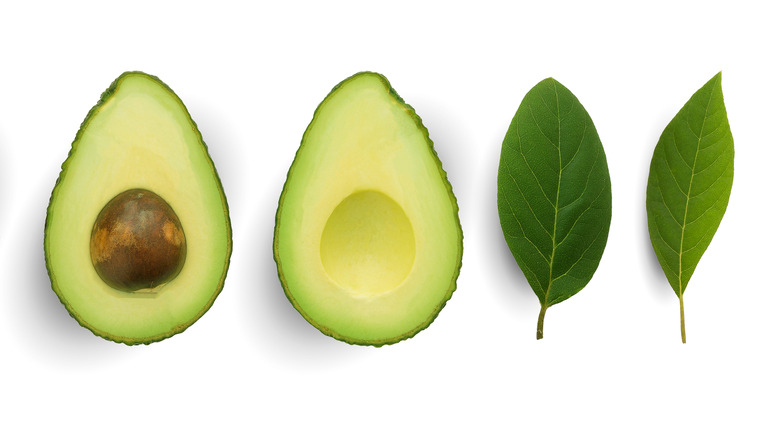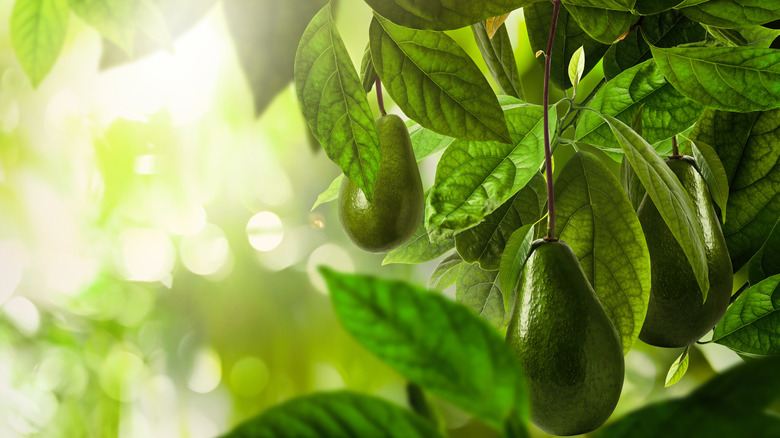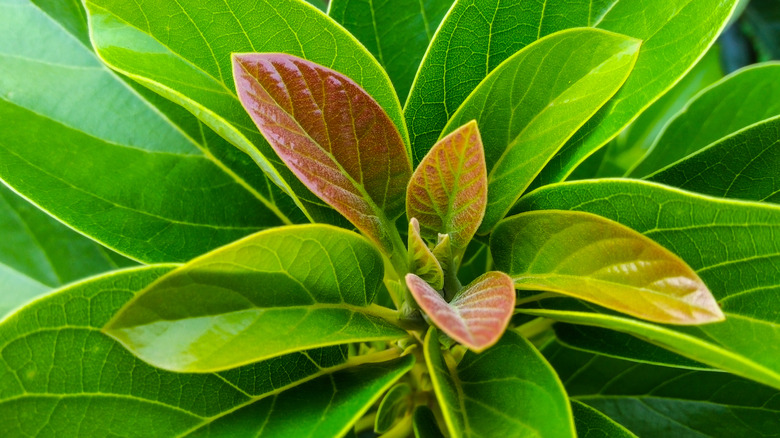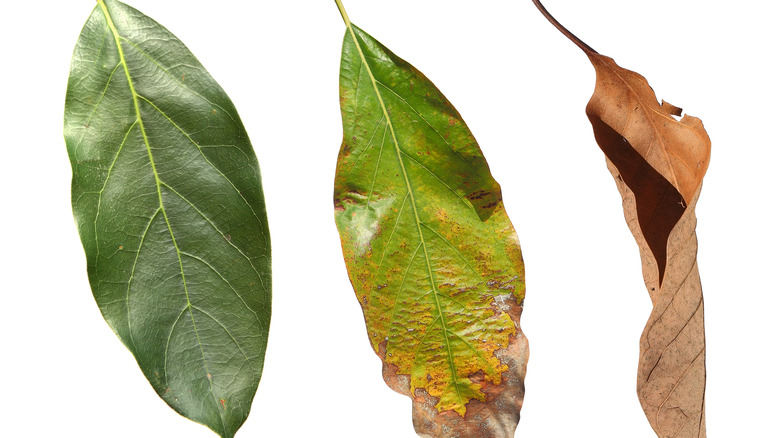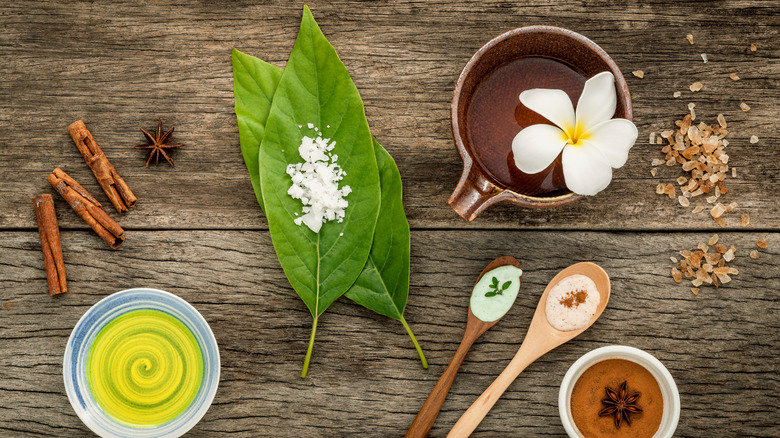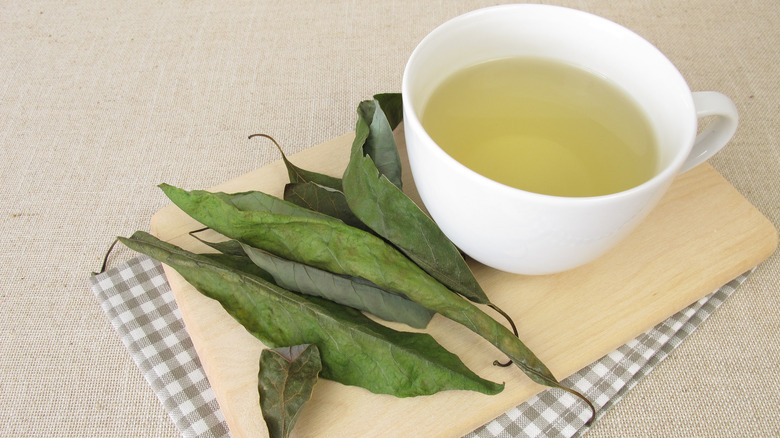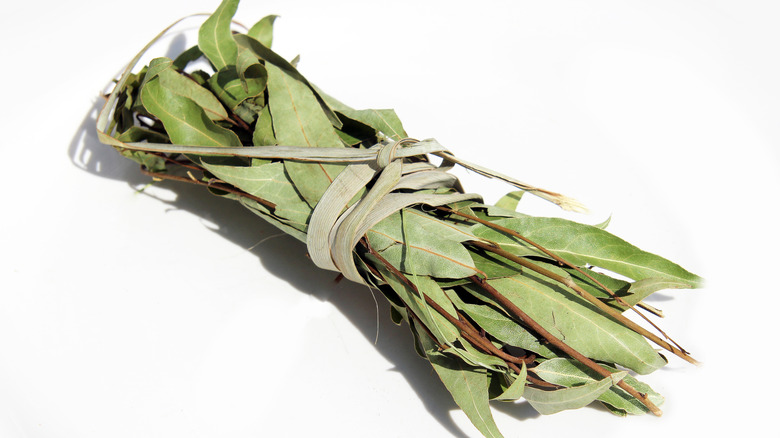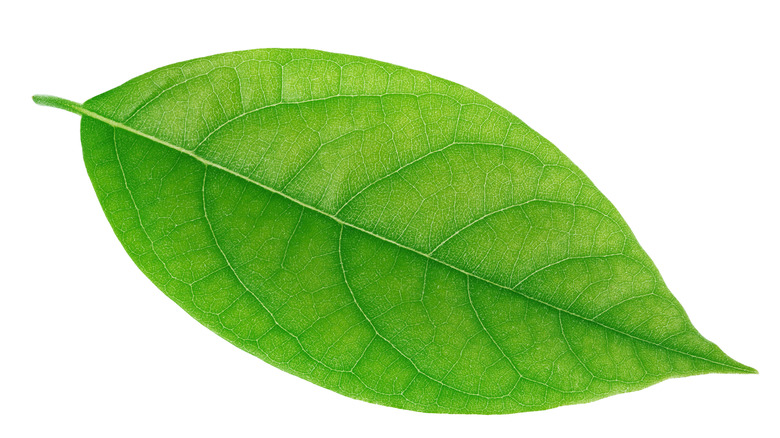What Are Hojas De Aguacate And How Do You Use Them?
Ah, the ever-popular avocado. The uses for the fleshy green fruit of the Persea americana plant grown in the US and Persea drymifolia grown in Mexico have skyrocketed over the past several decades, and today people can't get enough of the many products made from it. Enjoy the fruit on its own, make it into creamy guacamole, or cook it into a range of dishes — it's always delectable.
At the café, devotees splurge on avocado toast or BLT sandwiches with avocado. Many even use specialty avocado products like avo oil, skincare items, and more. Cute cartoon versions of the fruit adorn stickers, T-shirts, and stationery. So, it's not an overstatement to assert that we have a cultural obsession with all things avocado.
However, the fruit is not the only edible and delicious part of this plant. The avocado leaves, or hojas de aguacate, are an equally useful ingredient that's always been a part of Mexican cooking and are beginning to gain popularity in the US. Here's everything you need to know about hojas de aguacate, including how you can incorporate them into your cooking.
What are hojas de aguacate?
Hojas de aguacate are exactly what the Spanish phrase translates to in English: the leaves of the avocado plant. It is a traditional part of culinary culture in Oaxaca in the South Central region of Mexico. The food of that region is famous for its distinctive flavor, which is created by the seasonings unique to the region. Hojas de aguacate are a major ingredient in Oaxaca that typically used to season and add flavor to dishes like frijoles and salsa chintextle (via Esperanza Education).
Avocado leaves have long been used by indigenous cultures in Mexico as both a culinary ingredient and medicinal herb. The leaves are small- to medium-sized with a dark green, leathery surface on top and a lighter underside. Hojas de aguacate are long and slender with an elliptical shape and a green-white vein running through the center. The plant belongs to the Laurel family and is related to the bay leaf, which is similar in use and appearance to the avocado leaf (via Specialty Produce).
How are hojas de aguacate cultivated?
Of course, these leaves are not manufactured but grown naturally on avocado trees that are planted, cultivated, and harvested in groves on plantations.
Most avocado production occurs on groves in Mexico. If they grow in the United States, 90% of avocado groves are located in California and 10% are in Florida (via Food Source Information). The US industry is mostly focused on producing avocados, but leaves can also be cultivated on the same plantations. However, most of the hojas de aguacate are from Mexican plantations or small American groves that grow the Mexican species of avocado trees. They are usually dried and packaged as bundles of whole leaves before being sold as a seasoning.
You can even grow your own avocado tree and harvest hojas de aguacate from your home garden. California Avocado describes the process of developing shoots from the seed by planting the tree properly and maintaining ideal conditions so that the plant will flourish. While homegrown avocado trees don't usually develop fruit for the first five to 13 years, they will provide hojas de aguacate you can use in your cooking pretty early on in the process. If you grow your own hojas de aguacate, ensure it is the correct species, called Persea drymifolia. Haas avocado leaves are not good to eat and some varieties can be toxic, per Patch.
Fresh vs. dried hojas de aguacate
There are two main kinds of hojas de aguacate that are used in cooking. The leaves can be fresh, with no alteration or preparation. Or the leaves can be dried before being incorporated into whatever dish you are preparing. You can purchase either fresh or dry hojas de aguacate depending on how soon you intend to use them and which style you prefer.
Hojas de aguacate are usually dried as a preservation method. Dried avocado leaves can be stored easily in an airtight container for up to a year, while fresh avocado leaves only last a few days and must be stored in a container with water during that time (via Specialty Produce). As dried hojas de aguacate have a longer shelf life, they will likely be easier to find for purchase.
There is no change in the taste or quality between the fresh and dried varieties, so you can use either in your dish for maximum deliciousness.
What do hojas de aguacate taste like?
Hojas de aguacate have a very unique flavor unlike anything else. It's perfect as a seasoning for this very reason and, as such, is a distinctive part of Oaxacan cuisine. In Oaxaca, the leaves are frequently added to classic Mexican dishes like black beans to impart a complex and exciting taste.
The main flavor note of hojas de aguacate is similar to anise or licorice. There are rich undertones of hazelnut, and the aroma of the leaves is nutty and similar to tarragon. Imagine the leaves toasting on a comal or submerged in a simmering mole, steaming into your nostrils and diffusing its strong taste into the food you've seasoned with it. When used properly, the strong and delicious flavor steeps from the leaf into the hot dish you will soon savor.
With such a unique and strong taste, you might be shocked when you first cook with hojas de aguacate, but soon your tastebuds will absolutely crave it when you cook Mexican dishes.
How to cook with hojas de aguacate
The most common way hojas de aguacate are used as an ingredient is to season food. They're used like bay leaves, by adding them whole to a broth, mole, or soup, and then removing them before eating. The leaves can also be crushed up.
Hojas de aguacate acan be used exactly how you bought them, but it is very common to toast them before adding them to a dish. Toasting them will heighten the natural flavors — just do so for a minute on each side using a griddle or comal.
Fresh hojas de aguacate can be used to wrap around food while cooking to imbue them with the classic kick of flavor. The fresh leaves have the flexibility to surround the food, creating an envelope seeping flavor as the package cooks. They're often used this way to season meat and tamales.
The leaves can also be used to make tea. This tea was favored by indigenous people of Mexico as a medicine and health aid to help with a variety of ailments from skin irritation to menstrual problems (via Specialty Produce). Avocado tea is beginning to catch on as a new health food fad and even won awards at the World Tea Expo (via Well + Good).
Where to buy hojas de aguacate
You can find hojas de aguacate at any Mexican grocery store. Fresh avocado leaves, if they have them, will be in the produce section. Depending on where you live, fresh hojas de aguacate might not be available. Over in the seasoning aisle, however, you'll usually be able to spot bags of dried hojas de aguacate that are perfect to meet your craving for the unique flavor.
When picking your fresh hojas de aguacate, it can be helpful to compare the colors of the leaves for the best kind. Generally, the deeper the green, the more flavor the avocado leaf will have. A light-colored avocado leaf will not have as strong of a flavor. When purchasing dried varieties, look for whole, unbroken leaves in the bag. When the dried leaves are broken, their flavor will not be as powerful when they're added to a dish.
If you can't find hojas de aguacate, an alternative can be a regular bay leaf with a bit of anise. This won't perfectly replicate the flavor but will do in a pinch (via Rick Bayless).
Nutritional information about hojas de aguacate
In addition to great flavor, hojas de aguacate offer nutritional benefits. Avocado leaves have lots of fiber. They are also loaded with phenols, flavonoids, and other antioxidants that have anti-inflammatory effects. Other minerals and nutrients like potassium, iron, zinc, manganese, calcium, and sodium are found in hojas de aguacate, according to Specialty Produce.
It should be cautioned that there are some kinds of avocado leaves that can be dangerous, however. Studies have shown that some species of avocado trees, specifically the kind that produces the popular Haas avocado, have toxicity levels that can build up in your system and cause negative effects. These studies were conducted on animals and not humans, leaving definitive adverse effects on humans up for debate.
Luckily, Haas avocado trees are not typically used to produce hojas de aguacate. Leaves from Persea drymifolia, the Mexican species of avocado whose leaves are more commonly consumed, were not shown to be toxic when goats who ate the leaves were observed and tested (via Culinary Lore). Bottom line, toxicity in avocado leaves has caused concern in the past but is not something you need to be worried about if you buy hojas de aguacate that are purposely meant for cooking.
